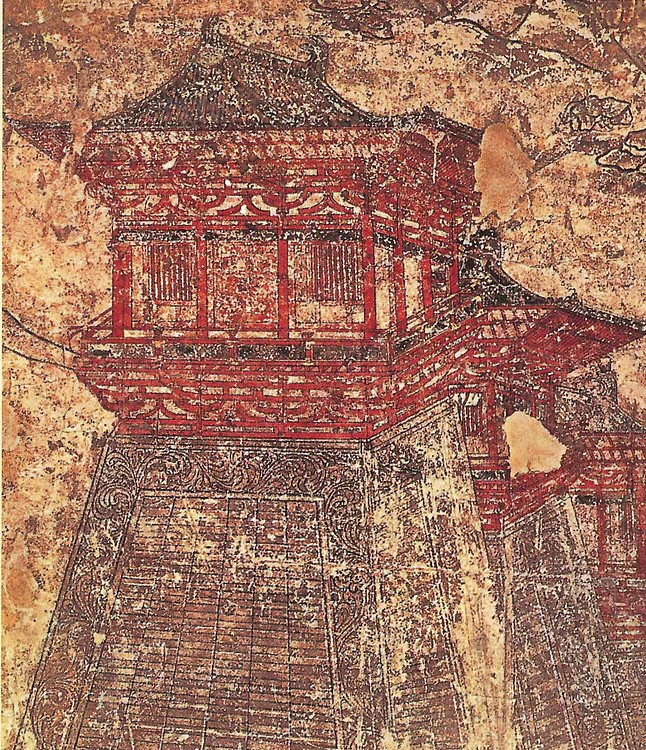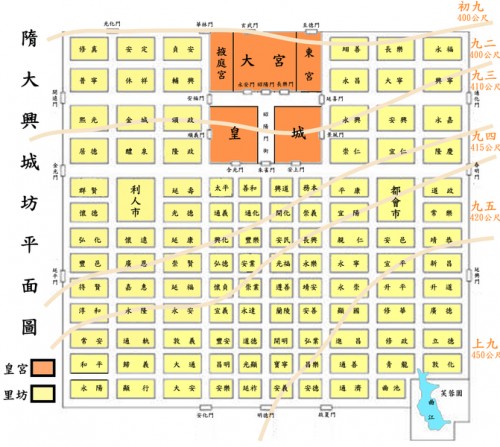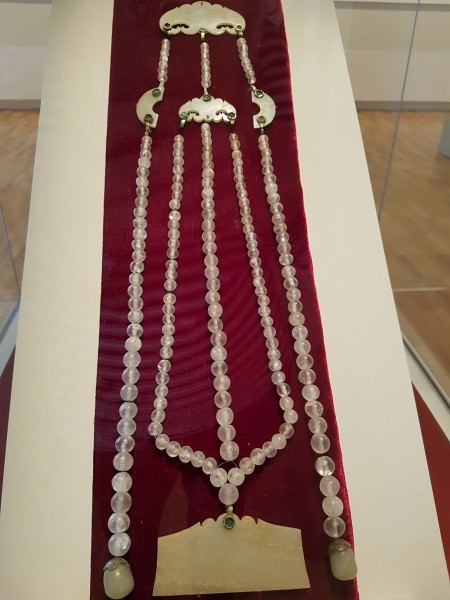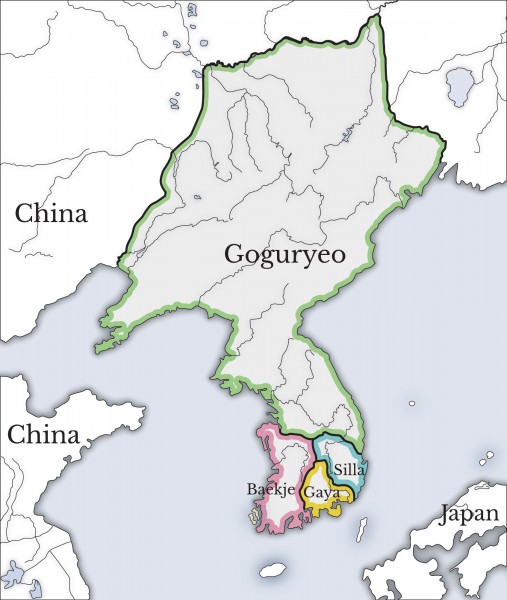Chang'an › Kim Yushin » Ancient origins
Articles and Definitions › Contents
- Chang'an › Ancient History
- Kim Yushin › Who Was
Ancient civilizations › Historical and archaeological sites
Chang'an › Ancient History
Definition and Origins

Chang'an, located near modern Xian in Shaanxi Province, was the capital of several dynasties of ancient China from the Zhou to the Tang and eventually became one of the world's great metropolises. With regular tree-lined avenues, high walls, pleasure parks, and areas dedicated to specific functions, it provided a model which was copied by other Asian capitals, notably in Japan and Korea.
EARLY SETTLEMENT & GEOGRAPHY
A settlement from Neolithic times, Chang'an was an ideal location for a capital as it was surrounded on all sides by mountains, providing a useful obstacle to invading armies, and was close to the Yellow and Wei Rivers. The advantages of the geographical location are described in the History of the Former Han Dynasty by Pan Ku,
In abundance of flowering plants and fruitsIt is the most fertile of the Nine ProvincesIn natural barriers for protection and defenceIt is the most impregnable refuge in heaven and earth(in Dawson, 59)
The name Chang'an translates as 'Forever Peace', and although not quite living up to its name, the city did remain important for well over a millennium. Chang'an was an important city in the Shang Dynasty (c. 1600-1046 BCE) but first became a capital under the Western Zhou (1046-771 BCE). When the Eastern Zhou dynasty (771-256 BCE) arose, the capital moved to Luoyang, Chang'an's great rival city which several times in Chinese history replaced it as capital.
THE HAN CAPITAL
After the turmoil of the Warring States period (481-221 BCE), Chang'an was capital again during the Western Han dynasty between 206 BCE and 9 CE. It has been suggested by ancient writers and some modern historians that the layout of the city was constructed to reflect exactly the corner points of the Great Bear constellation, but sceptics point to the evolutionary development of the city as an argument against this possibility. The city was given an armoury, a state-controlled market and a granary, projects supervised by Emperor Gaozu's chief minister Xiao He, who was subsequently rebuked for his excessive spending. The next emperor, Hui, saw the value to his reign of a capital that looked the part and ordered a new market, new walls, a mausoleum for Gaozu and an ice-house in the royal residence. The capital even had its own police force, headed by the superintendent of the capital, the Zhijinwu.
Emperor Wu, the fifth Han ruler, renovated two palaces and built three more. His most famous building project was the redevelopment of the Shanglin Park. Located to the south-west of the city, it had fallen into disrepair and Wu completely transformed it into a pleasure park with artificial water features, the Jianzhang Palace which became the royal residence, and many subsidiary structures. The park contained all manner of exotic flowers, tropical plants and trees and was given several statues including a whale and replica of the Milky Way. There was even a menagerie which included exotic birds, a rhinoceros, and an elephant.
IN THE EARLY PERIOD CHANG'AN WAS DOMINATED BY THE WEIYANG PALACE WHICH WAS BUILT ON CUT TERRACES ON THE DRAGON HEAD HILLS ABOVE THE CITY.
In this early period Chang'an was dominated by the Weiyang Palace which was built on cut terraces on the Dragon Head Hills above the city. The capital was next significantly developed by the early 1st-century CE Han regent and usurper Wang Mang.Mang built an imperial ceremonial hall ( piyong ), hall of light ( mingtang ) where the change in seasons was observed, and spirit terrace ( lingtai ) but even more celebrated were his nine temples ( jiu miao ), where the ancient kings of China were worshipped, the foundations of which still remain today. One such temple was a square structure with four doors set within a circular precinct with four gates. The city eventually reached an extent of around 450 hectares (c. 1110 acres). In addition, to the north of the River Wei, whole towns sprang up around the sites of the Qin and Han Royal tombs. The whole valley was becoming a major concentration of people.
THE SOUTHERN & NORTHERN DYNASTIES
After Luoyang had served as the capital of the Later/Eastern Han (23-220 CE), Chang'an returned as capital of many subsequent different dynastic states during the complex period of China's history known as the Southern and Northern Dynasties: the Jin (311-316 CE), the Zhao (319-329 CE), Qin (351-385 CE), Later Qin (386-417 CE), Western Wei (535-554 CE), and Northern Zhou (557-581 CE). The city was the capital of the Sui Dynasty (581-618 CE), which unified China once more, when it was redesigned by Emperor Wendi.
THE TANG CAPITAL
During the Tang Dynasty (618-907 CE) Chang'an was still the capital and became one of the great cities of the world and most important in East Asia. In the 8th century CE, at its peak, the city probably had the largest concentrated population on earth: close to 3 million inhabitants (one million inside the city walls and another 2 million in the surrounding suburbs. These people were drawn from all over China and included many immigrants, lured by the great commerce of the city, positioned as it was at the end of the Silk Road which crossed Asia. All manner of goods from furniture to spices were traded in the city's two great marketplaces.

Chang'an Street Plan
The city now covered some 8,600 hectares (c. 21,250 acres) and was enclosed within 5.3-metre high walls made of packed earth which had gates on each side, the main one being the South Gate. Laid out on a rectangular grid pattern with 114 individually walled blocks, there were wide avenues and streets - 11 running from north to south and 14 from east to west - which were tree-lined and had ditches along their sides for drainage. There were canals, too, to better facilitate the movement of goods across the city and to link it to the areas of Peking in the north and the Yangtze Valley and Hangchow to the south.Certain areas of the city were dedicated to specific purposes such as manufacturing, commerce, and religion, as well as parks and private residential estates.
The tallest buildings would have been religious with Buddhist temples and pagodas dotting the city. For an idea of what these looked like it is today better to visit Japan than China where such temples as the Horyuji in Nara preserve the architectural plan and style of a typical Chinese temple of the 7th century CE. The temples of Chang'an, besides offering regular religious spectacles, relics for worship such as four of the Buddha ’s teeth, and artworks for the public's pleasure, also provided help to the poor, public baths and medicine and treatment for the sick. The government and palace buildings had their own walled compounds, and there were even areas for the use of visiting foreign embassies. Finally, in the south-east corner of the city was a huge pleasure garden with a lake, lotus ponds, flower gardens, and pavilions. There, people could enjoy the natural beauty, boat on the lake, and see festivals and shows put on by the emperor when colourful tents were set up for banquets and orchestras.
The city never stopped expanding or developing. In 634 CE Emperor Taizong established a new palace, the Great Luminous Palace ( Daming gong ) which was built in the great hunting park on the northern edge of the city. The palace, already grandiose, was further extended by Emperor Gaozong in 662 CE and included vast flower gardens and water features. The Hanlin Academy ( Hanlin yuan ) was founded in 725 CE by Emperor Xuanzong as a place of study for scholars, artists, writers, and astrologers. Meanwhile, the Pear Garden became a celebrated training school for actors, singers, and dancers.

Jade & Crystal Ornament
DECLINE & LEGACY
Chang'an's glory days came to an abrupt end when it was sacked by Huang Chao in 880 CE who led a rebellion against the government which had already been weakened by years of warlords and bandits rampaging the countryside. Attacked again in 904-906 CE by the warlord Zhu Quanchong, Chang'an was replaced as capital by Luoyang once again. As much of the city's architecture was of wood, the more important buildings were dismantled and relocated while others were simply abandoned to decay. Eventually, the once great city became overgrown and the area was used for agriculture, just as it had been 2,000 years before. The city's ruin was eloquently described by the Tang poet Wei Chuang:
Desolate city of Changan, what do you now contain?Ruined bazaars, deserted streets where tender wheat-ears grow.Collecting fuel, they cut down every flower in Almond Park;For barricades they rooted out the willows of the Grand Canal.Gay-painted coaches, patterned wheels, have scattered long ago;Of splendid mansions, grand vermilion gates, not half remain!(Dawson, 61)
The city may have quickly disappeared physically but it did leave a tangible legacy in that Chang'an greatly influenced other capitals in East Asian states who were eager to be seen as civilised and advanced as China. Nara and it successor Heiankyo(Kyoto) in Japan and Gyeongju, the capital of the Silla kingdom in Korea, are prominent examples where the high walls, grid layout with wide avenues and segregated city districts of Chanag'an were imitated.
Kim Yushin › Who Was
Definition and Origins

Kim Yushin (aka Kim Yu-sin, 595-673 CE) was a general of the Silla kingdom which ruled south-eastern Korea during the Three Kingdoms Period. Kim would greatly help Silla unify Korea, famously leading a massive army to crush the rival kingdom of Baekje ( Paekche ) in the 660's CE. His feats won him legendary status in his own lifetime, an elevated position he still enjoys in Korea today.
EARLY LIFE & LEGENDS
Kim was a descendant of the royal house of Gaya ( Kaya ), a confederation which ruled to the west of the Silla kingdom from 42 to 532 CE before it was conquered by its more powerful neighbour. Various legends concerning Kim appear in the Samguksagi ('Historical Records of the Three States') written in 1146 CE by Kim Pusik. One such legend has it that before his birth his father dreamed of the planets Saturn and Mars falling on top of him while his mother dreamed that a small boy came into her room wearing brilliantly shining golden armour while he floated on a cloud, both powerful omens of his future glittering military career.
At the age of 14 he joined the hwarang ('Flower Boys'), a Silla group of elite teenagers who sang and danced and studied the principles of Confucianism and Buddhism. Kim Yushin's particular group was known as the 'Band of the Dragon Flower Tree,' and Kim was reportedly a model of good deeds and spirituality. Another legend from the Samguk sagi tells of the time Kim entered a cave in the mountains at age 16. After purifying himself and praying for four days, he swore to heaven that he would battle and defeat the kingdom of Goguryeo ( Koguryo ) and the Malgal tribes of the north. An old man then sees the young Kim and, on hearing of his resolve, gives him a magic formula of unknown description. One year later Kim, now in a deep valley, goes through the same process and asks the heavens for his sword to be given special powers. After three days a light shines down from the skies and the sword shakes. These legends help to explain the great military feats achieved by Kim when he later becomes a general of the Silla army.
LEGENDS IN THE ' SAMGUK SAGI ' HELP TO EXPLAIN THE GREAT MILITARY FEATS ACHIEVED BY KIM WHEN HE SERVED AS A GENERAL OF THE SILLA ARMY.
On reaching adulthood he married the sister of his good friend, the celebrated diplomat Kim Chunchu (d. 661 CE) and later helped him take the throne of Silla as King Muyeol (r. 654-661 CE) and forge closer relations with China 's powerful Tang dynasty (618-907 CE). Together, the pair is known as 'the Two Kims.' King Muyeol then took as his queen the youngest sister of Kim Yushin, who, with her royal Gaya lineage, helped to provide greater unity to the new Unified Kingdom of Silla.
RESCUE OF KIM CHUNCHU
In 641 CE, during the reign of Queen Seondeok (632 to 647 CE), Kim Chunchu was sent on a diplomatic mission to King Pojang of Goguryeo for help against an ever-more aggressive Baekje. The Goguryeo king, though, would only help if Silla gave up some of the territory they had previously taken from his kingdom. Seondeok refused and so Chunchu was imprisoned.The queen then dispatched a 10,000-man army led by Kim Yushin, now a general, to rescue Chunchu and rebuke Pojang for his impudence. When the Goguryeo monarch discovered an army was on its way, he promptly released his captive without any bloodshed.
CONQUERING KOREA
The Three Kingdoms of Korea - Silla, Baekje and Goguryeo - had been battling each other for centuries, but the formation of a massive joint Tang and Silla army and naval force in 660 CE finally decided which of them would control the peninsula. The Silla army of 50,000 was led by Kim Yushin whilst Tang emperor Gaozong sent a navy of 130,000 men which sailed up the Paek (modern Kum) River commanded by the general Su Dingfang. Facing such an overwhelming force on two fronts, Baekje was caught in a pincer movement when Kim Yushin crossed the Sobaek mountains. The armies met on the Hwangsan Plain, and the Baekje army led by general Kyebaek was routed. The capital Sabi was crushed and the kingdom wholly swept aside.

Three Kingdoms of Korea
Once again the Tangs were instrumental in Korean affairs when Pyongyang, the Goguryeo capital, was attacked by a Chinese army in 661 CE. The siege was not successful, though, and only the actions of Kim Yushin, who managed to supply massive quantities of rice, saved the Tang army from a winter capitulation. Another Kim legend recounted in the Samguk sagihappens at this time. When the Silla fortress at North Han Mountain was besieged for ten days by a joint Goguryeo and Malgal force a bright star fell towards the camp of the besiegers and this momentous event was immediately followed by earthquakes and torrential rains. In dread fear the enemies fled their camp and this unexpected relief is widely credited to Kim's request for divine assistance in a Buddhist monastery.
Returning to more definite history, Goguryeo would not last much longer, and with Kim by now in retirement, another Tang army again besieged Pyongyang in 667 CE. The city eventually fell in 668 CE, and the Goguryeo kingdom was made a Chinese province. This left the way clear for Silla to unify Korea and rule alone, which it did as the Unified Silla Kingdom until 935 CE.

Tomb of Kim Yushin, Gyeongju
RETIREMENT & TOMB
As a reward for his efforts in helping Silla dominate the Korean peninsula, Kim was granted his own sigup or tax village. This was a Silla honour given to prominent members of the ruling elite and allowed them to extract whatever wealth or labour they wished from their designated area. Kim was given an unprecedented 500 households, 500 kyol (approx. 1000 acres) of farmland, and six horse farms. The great general presumably retired either to, or on the income of, this estate. After his death in 673 CE, Kim was buried in a large earth mound tomb which lies at the former Silla capital of Gyeongju. The mound is surrounded by 12 stone slabs, each with a sign of the oriental animal zodiac carved on it in relief to provide eternal protection for the general within. His genes lived on as his son, Wonsul, was a famous member of the hwarang, and his great-great-grandson, Kim Am, was a celebrated astronomer in the 8th century CE.
This article was made possible with generous support from the British Korean Society.
LICENSE:
Article based on information obtained from these sources:with permission from the Website Ancient History Encyclopedia
Content is available under License Creative Commons: Attribution-NonCommercial-ShareAlike 3.0 Unported. CC-BY-NC-SA License